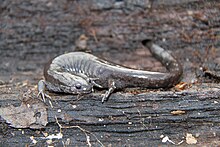Small-mouthed salamander
| Small-mouth salamander | |
|---|---|
 |
|
| Scientific classification | |
| Kingdom: | Animalia |
| Phylum: | Chordata |
| Class: | Amphibia |
| Order: | Caudata |
| Family: | Ambystomatidae |
| Genus: | Ambystoma |
| Species: | A. texanum |
| Binomial name | |
|
Ambystoma texanum Matthes, 1855 |
|
| Synonyms | |
|
Salamandra texana |
|
Salamandra texana
Matthes, 1855
Amblystoma microstomum
Cope, 1861
Chondrotus microstomus
Cope, 1887
Ambystoma schmidti
Taylor, 1939
Linguaelapsus schmidti
Freytag, 1959
Linguaelapsus texanus
Freytag, 1959
Ambystoma nothagenes
Kraus, 1985
The small-mouth salamander (Ambystoma texanum) is a species of mole salamander found in the central United States, from the Great Lakes region in Michigan to Nebraska, south to Texas, and east to Tennessee, with a population in Canada, in Pelee, Ontario. It is sometimes referred to as the Texas salamander, porphyry salamander, or the narrow-mouthed salamander. The Kelley’s Island salamander (Ambystoma nothagenes) was synonymized with A. texanum in 1995.
The small-mouth salamander grows from 4.5 to 7.0 in. It is typically black or dark brown in color with light-grey or silvery-colored flecking, or grey blotching. It has a fairly small head, relative to its body, and a long tail. Males are typically smaller than females. Their bellies are black, often with tiny flecks, and have 14 to 15 costal grooves.
Small-mouth salamanders are nocturnal, often subterranean, preferring moist habitats near permanent bodies of water. Breeding occurs in the spring, with groups of salamanders congregating near the water. Females can lay up to 700 eggs, which they attach in small clumps of up to 30 eggs at a time, to rocks or vegetation under the water. Their diets include insects, slugs, and earthworms. Larvae hatch at 0.5 in (13 mm); they metamorphisize in May to June at about 1.6 in (40 mm). When disturbed, the small-mouth salamander raises its tail and waves it back and forth. Being shy and sensitive, it shares breeding pools with larger spotted salamanders and marbled salamanders.
...
Wikipedia

